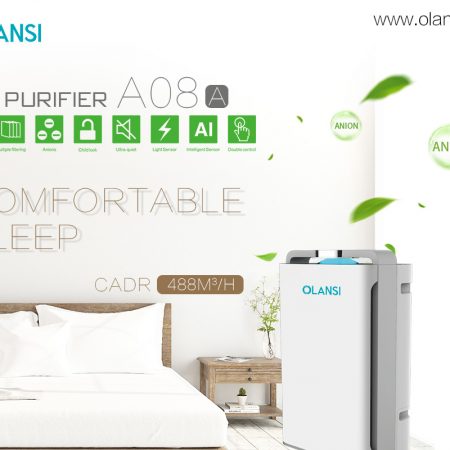Can air purifiers help you breathe easier?
If you suffer from allergies or asthma or any other condition that’s made worst by airborne particles, an oem air purifier may provide you with some — or quite a bit — of relief. People who smoke or have pets also like them for reducing odors, as well as removing smoke and pet dander.
Air purifiers do their work using different technologies, and some use multiple technologies, to deal with airborne pollutants. HEPA air purifiers use pleated high-efficiency particulate arresting (HEPA) filters to mechanically trap particles, along with a fan to pull air through the filter. Reviewers say this type of air purifier is by far the most effective. These models don’t produce any ozone, either. Because they use fans, they can be noisy, but some actually like the sound a china air purifier makes, likening it to a white noise machine. Not every home air purifier that relies on mechanical filtration uses true HEPA filters, so be sure that you are getting that technology if that’s what you decide you want.
Some air purifiers use electronic technology in place of or in addition to a mechanical filter. Electronic ionizers air purifeir work by reversing the charge of particles in the air. The charged particles are then passed back out to the room where they are attracted to objects such as clothing, walls, floors and furniture. In effect, particles are removed from the air and deposited on your furnishings and clothing. You need to dust and vacuum to actually remove allergens from the room and prevent them from being reintroduced into the air. Some air purifiers have an electrostatic precipitator that works by putting a charge on particles and then collecting those using oppositely charged metal plates.
While both types of electronic air purifiers are effective for collecting particles as small as .1 microns, they can also produce a small amount of ozone, a lung irritant, though typically at levels below the standard set as safe by Underwriters Laboratory and by government agencies. Some electronic air cleaners put a small charge on a mechanical filter to help it collect particles more effectively. With that type of air cleaner, the charge is low enough that measurable amounts of ozone are not produced.
Ionic and electrostatic air purifiers emit small amounts of ozone as a byproduct, but ozone generators sold as air purifiers emit high levels intentionally to neutralize chemical irritants and odors. Research has shown that, while this can be effective, it’s also fairly dangerous. The best advice we found is to avoid ozone generators altogether. For more information, see our discussion of air purifiers and ozone elsewhere in this report.
Another alternative is to consider a whole-house furnace filter. These aren’t air purifiers; they simply replace your regular furnace filter. Most filters of this type do a pretty decent job of removing dust, pollen and smoke. Whole house filters need to be replaced every three months otherwise their airflow could be reduced, which makes them less effective.
It’s important to note that, with the exception of ozone generators, none of the mechanical or electronic air purifying techniques above are particularly effective against chemical gases or strong odors. Some air purifiers add some type of chemical filtration — typically activated carbon — to deal with those irritants. The most effective of those sell for a premium price compared to the majority of air cleaners, but if you suffer from chemical sensitivities, they might be worth every penny.
Finding the best air purifiers
To find the top performing air purifiers, we consult professional reviews, such as those from ConsumerReports.org and The Sweethome.com. We also consider whether or not an air purifier has been submitted for testing and has had its ratings certified by the Association of Home Appliance Manufacturers (AHAM). Rounding things out, we analyze the hundreds and sometimes thousands of user reviews some air purifiers have garnered at sites like Amazon.com, AllergyBuyersClub.com and elsewhere. Armed with that information, we consider factors such as performance, ease of use and noise. Finally, we analyze the full cost of the unit, which includes both the initial cost and the ongoing costs of filter replacement. The results of that research helps us to narrow down our recommendations for the top air purifiers for any space or budget.
Blue Air and IQAir are near-commercial quality air purifiers
In reviewing air purifiers, we discovered that the most satisfied customers are those who understand the limitations of an air purifier and adjust their expectations accordingly. Portable air cleaners can remove only airborne pollutants, they are not very effective against dust mites and their droppings (those are too heavy to be airborne for long), which are a significant allergen for many people. Most air cleaners also don’t remove most viruses, or gases like carbon monoxide and radon. That’s because even air purifiers with true HEPA filters are most effective on particles larger than 0.3 microns, such as molds, pollen, dust, plant spores, pet dander and the larger particles in cigarette smoke.
Some air purifiers do a better job with smaller particles however. Among those, we see consistently good feedback for the Blueair 503 (Est. $660). It’s a fast worker that is rated to remove particles down to 0.1 microns. It’s Recommended in one large independent review. TheSweethome.com also gives the Blueair top grades for performance. Value is a concern as it’s pricier to begin with, and more costly to operate than other air purifiers that are also judged to be effective, but that’s offset by the ability to filter particles out of the air faster than other tested machines.
User reviews are also highly positive, with many owners saying they see a noticeable difference in their air quality, the amount of dust on their furniture, or in their allergy or asthma symptoms. Many also note that the Blueair is a very good choice for a larger room. The Blueair 503 is rated for rooms up to 580 square feet. Experts note that while the standard Blueair Particle Filters (Est. $80 per set) do a great job with particles, they aren’t effective against odors or gases. If that’s a concern, you can use Blueair’s optional SmokeStop Filter (Est. $150) instead, and those are judged to do a great job of getting rid of odors. However, the SmokeStop filters cut back on the 503’s filtration rate and add a bit to the unit’s annual operating cost.
Noise gets mixed feedback. One review says that noise at low speeds is minimal, but a little excessive at high speed. As we see with any product that produces a sound, some owners find it very loud, others very quiet. Some even say they love the Òwhite noiseÓ effect that the drone of the air purifier produces. The five year warranty is good, but users need to make sure they register (it’s free) and stay current with the machine’s required maintenance to keep it in force, including changing the filters every six months (regardless of type) with official Blueair filters.
Among premium air purifiers, we’ve seen some widely differing feedback on the IQAir New Edition HealthPro Plus (Est. $935). At AllergyBuyingClub.com it is one of their top-rated air purifiers, earning a perfect 5-star expert rating and equally impressive ratings from owners. Elsewhere, users say they are very pleased with this unit’s performance, with plenty saying they upgraded to the IQAir after they saw no discernable difference in air quality from a cheaper machine, and that the IQAir is worth every penny. It’s also the best choice for large rooms as it’s rated to handle up to 1,125 square feet.
IQAir does not submit itsair purifiers for voluntary testing by The Association of Home Appliance Manufacturers (AHAM), however TheSweethome.com tests the New Edition HealthPro Plus and John Holocek has mixed impressions. In that review the HealthPro Plus edges out the Blueair 503 with the StopSmoke filters when it comes to removing odors, but it is in turn edged out when it comes to particle removal. What tilts the scale toward the Blueair 503 is operating costs. The HealthPro Plus “had the highest power consumption over five years of $1,236, more than double that of any other unit,” says Holecek. “Budget a whopping $2,276 over the first five years for operating costs alone,” he adds. However, if your health care professional can provide evidence of medical necessity, you may be able to purchase this unit and its replacement filters through your FSA.
Part of that cost is the sophisticated series of filters used by the HealthPro Plus. The filter complement includes a PreMax Pre-Filter (Est. $80), IQAir’s clean room-quality HyperHEPA filter(Est. $200) and a V5-Cell Filter (Est. $100) that includes two types of media for gas and odor elimination. The PreMax filters are designed to last up to 18 months, while the HyperHEPA filter lasts up to four years. The V5-Cell filter should be replaced approximately every two years.
Whether or not the HealthPro Plus can fully live up to its claim of being able to remove particles down to 0.003 microns in size — about 10 times smaller than a virus and 100 times smaller than standard air-filtration technology — it’s undoubtedly effective. Its performance is in the top rank at TheSweethome.com, with Holecek calling it the “gold standard” among air purifiers.
If you want a premium grade air purifier, but only need it for a smaller room, the Blueair 403 (Est. $550) is one to consider. This is the little brother to our Best Reviewed Blueair 503, but it’s AHAM rated to handle rooms up to 370 square feet. The 403 has four fan speed settings. Like the Blueair 503, the Blueair 403 meets UL standards for ozone emissions — but it has lower clean air delivery rates (CADRs) than its more expensive sibling. It also has manual controls instead of the electronic controls the higher-up model offers, although the control knob is simple to operate. Other features include a filter countdown that alerts owners when it’s time to replace the Blueair 400 Series Filters (Est. $60 per set), which is about every six months — and be sure not to skimp on that if you want to keep the five-year warranty in effect. If odors or gases are an issue, there’s an optional SmokeStop Filter (Est. $120) similar to the one available for the 503 that can be used in place of the standard one.


